charging MERCEDES-BENZ S CLASS 2019 Owners Manual
[x] Cancel search | Manufacturer: MERCEDES-BENZ, Model Year: 2019, Model line: S CLASS, Model: MERCEDES-BENZ S CLASS 2019Pages: 578, PDF Size: 23.31 MB
Page 4 of 578
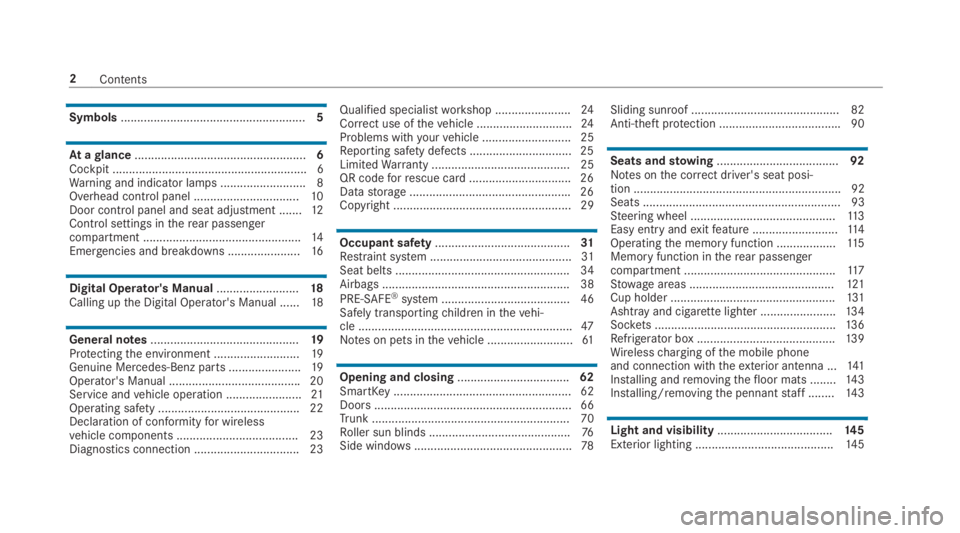
Symbols........................................................5
Ataglance....................................................6Cockpit ........................................................... 6Warning and indicator lamps .......................... 8Overhead control panel ................................10Door control panel and seat adjustment .......12Control settings intherear passengercompartment ................................................14Emergencies and breakdowns ......................16
Digital Operator's Manual.........................18Calling upthe Digital Operator's Manual ......18
General notes.............................................19Protectingthe environment ..........................19Genuine Mercedes-Benz parts ......................19Operator's Manual ........................................20Service andvehicle operation .......................21Operating safety ...........................................22Declaration of conformityfor wirelessvehicle components .....................................23Diagnostics connection ................................ 23
Qualified specialistworkshop .......................24Correct use ofthevehicle .............................24Problems withyourvehicle ........................... 25Reporting safety defects ...............................25LimitedWarranty .......................................... 25QR codeforrescue card ...............................26Datastorage .................................................26Copyright ...................................................... 29
Occupant safety.........................................31Restraint system ...........................................31Seat belts ..................................................... 34Airbags ......................................................... 38
PRE-SAFE®system ....................................... 46Safely transportingchildren inthevehi‐cle .................................................................47Notes on pets inthevehicle ..........................61
Opening and closing..................................62SmartKey...................................................... 62Doors ............................................................ 66Trunk ............................................................ 70Roller sun blinds ...........................................76Side windows................................................78
Sliding sunroof ............................................. 82Anti-theft protection .....................................90
Seats andstowing.....................................92Notes onthe correct driver's seat posi‐tion ............................................................... 92Seats ............................................................ 93Steering wheel ............................................11 3Easy entry andexitfeature ..........................11 4Operatingthe memory function ..................11 5Memory function intherear passengercompartment ..............................................11 7Stowage areas ............................................121Cup holder ..................................................131Ashtrayand cigarettelighter .......................134Sockets .......................................................13 6Refrigerator box ..........................................13 9Wirelesscharging ofthe mobile phoneand connection withtheexterior antenna ...141Installing andremovingthefloor mats ........14 3Installing/removingthe pennantstaff ........14 3
Light and visibility...................................14 5Exterior lighting ..........................................14 5
2Contents
Page 25 of 578
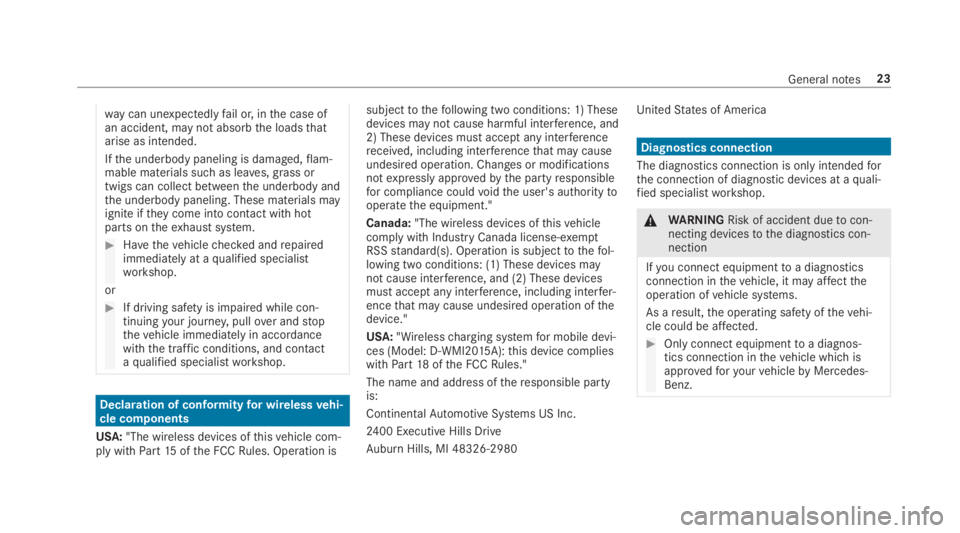
way can unexpectedlyfail or, inthe case ofan accident, may not absorbthe loadsthatarise as intended.
Ifthe underbody paneling is damaged,flam‐mable materials such as leaves, grass ortwigs can collect betweenthe underbody andthe underbody paneling. These materials mayignite iftheycome into contact withhotparts ontheexhaust system.
#Havethevehiclechecked andrepairedimmediately at aqualified specialistworkshop.
or
#If driving safety is impaired while con‐tinuingyour journey,pullover andstopthevehicle immediately in accordancewiththe traffic conditions, and contactaqualified specialistworkshop.
Declaration of conformityfor wirelessvehi‐cle components
USA:"The wireless devices ofthisvehicle com‐ply withPart15ofthe FCCRules. Operation is
subjecttothefollowing two conditions: 1) Thesedevices may not cause harmful interference, and2) These devices mustaccept any interferencereceived, including interferencethat may causeundesired operation. Changes or modificationsnotexpressly approvedbythe partyresponsiblefor compliance couldvoidthe user's authoritytooperatethe equipment."
Canada:"The wireless devices ofthisvehiclecomply with Industry Canada license-exemptRSSstandard(s). Operation is subjecttothefol‐lowing two conditions: (1) These devices maynot cause interference, and (2) These devicesmustaccept any interference, including interfer‐encethat may cause undesired operation ofthedevice."
USA:"Wirelesscharging systemfor mobile devi‐ces (Model: D-WMI2015A):this device complieswithPart18ofthe FCCRules."
The name and address oftheresponsible partyis:
ContinentalAutomotive Systems US Inc.
2400 Executive Hills Drive
Auburn Hills, MI 48326-2980
UnitedStates of America
Diagnostics connection
The diagnostics connection is only intendedforthe connection of diagnostic devices at aquali‐fied specialistworkshop.
&WARNINGRisk of accident duetocon‐necting devicestothe diagnostics con‐nection
Ifyou connect equipmenttoa diagnosticsconnection inthevehicle, it may affecttheoperation ofvehicle systems.
As aresult,the operating safety ofthevehi‐cle could be affected.
#Only connect equipmenttoa diagnos‐tics connection inthevehicle which isapprovedforyourvehiclebyMercedes-Benz.
General notes23
Page 26 of 578
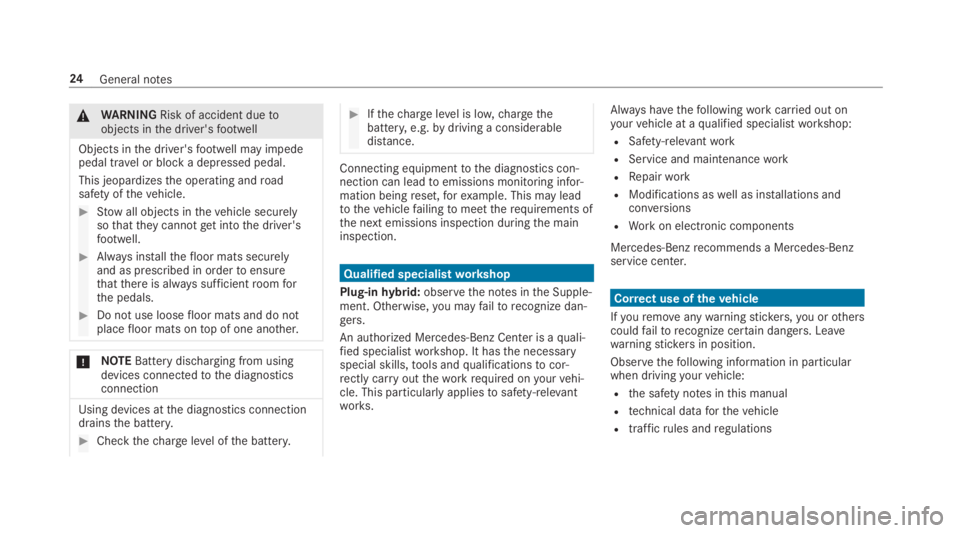
&WARNINGRisk of accident duetoobjects inthe driver'sfootwell
Objects inthe driver'sfootwell may impedepedal travel or block a depressed pedal.
This jeopardizesthe operating androadsafety ofthevehicle.
#Stowall objects inthevehicle securelysothattheycannotgetintothe driver'sfootwell.
#Always installthefloor mats securelyand as prescribed in ordertoensurethatthere is always sufficientroomforthe pedals.
#Do not use loosefloor mats and do notplacefloor mats ontop of one another.
*NOTEBattery discharging from usingdevices connectedtothe diagnosticsconnection
Using devices atthe diagnostics connectiondrainsthe battery.
#Checkthechargelevel ofthe battery.
#Ifthechargelevel is low,chargethebattery,e.g.bydriving a considerabledistance.
Connecting equipmenttothe diagnostics con‐nection can leadtoemissions monitoring infor‐mation beingreset,forexample. This may leadtothevehiclefailingtomeettherequirements ofthe next emissions inspection duringthe maininspection.
Qualified specialistworkshop
Plug-inhybrid:observethe notes inthe Supple‐ment. Otherwise,you mayfailtorecognize dan‐gers.
An authorized Mercedes-Benz Center is aquali‐fied specialistworkshop. It hasthe necessaryspecial skills,tools andqualificationstocor‐rectly carryouttheworkrequired onyourvehi‐cle. This particularlyappliestosafety-relevantworks.
Always havethefollowingworkcarried out onyourvehicle at aqualified specialistworkshop:
RSafety-relevantwork
RService and maintenancework
RRepairwork
RModifications aswell as installations andconversions
RWorkon electronic components
Mercedes‑Benzrecommends a Mercedes‑Benzservice center.
Correct use ofthevehicle
Ifyouremoveanywarningstickers,you orotherscouldfailtorecognize certain dangers. Leavewarningstickersin position.
Observethefollowing information in particularwhen drivingyourvehicle:
Rthe safety notes inthis manual
Rtechnical dataforthevehicle
Rtrafficrules andregulations
24General notes
Page 76 of 578
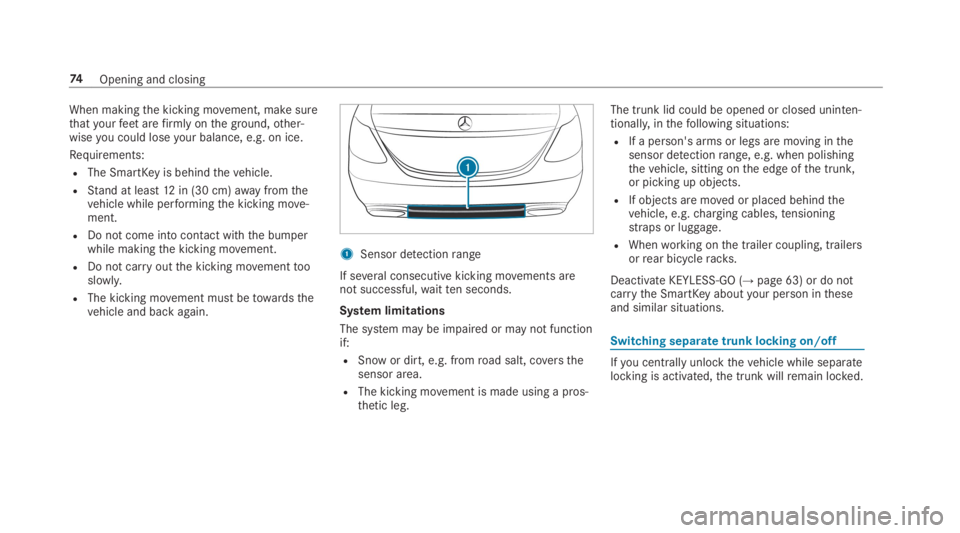
When makingthe kicking movement, make surethatyourfeetarefirmly onthe ground,other‐wiseyou could loseyour balance, e.g. on ice.
Requirements:
RThe SmartKeyis behindthevehicle.
RStand at least12in (30 cm)awayfromthevehicle while performingthe kicking move‐ment.
RDo not come into contact withthe bumperwhile makingthe kicking movement.
RDo not carryoutthe kicking movementtooslowly.
RThe kicking movement must betowardsthevehicle and back again.
1Sensor detectionrange
If several consecutive kicking movements arenot successful,waitten seconds.
System limitations
The system may be impaired or may not functionif:
RSnow or dirt, e.g. fromroad salt, coversthesensor area.
RThe kicking movement is made using a pros‐thetic leg.
The trunk lid could be opened or closed uninten‐tionally, inthefollowing situations:
RIf a person's arms or legs are moving inthesensor detectionrange, e.g. when polishingthevehicle, sitting onthe edge ofthe trunk,or picking up objects.
RIf objects are moved or placed behindthevehicle, e.g.charging cables,tensioningstraps or luggage.
RWhenworking onthe trailer coupling, trailersorrear bicycleracks.
Deactivate KEYLESS-GO (→page 63) or do notcarrythe SmartKeyaboutyour person intheseand similar situations.
Switching separate trunk locking on/off
Ifyou centrally unlockthevehicle while separatelocking is activated,the trunk willremain locked.
74Opening and closing
Page 143 of 578
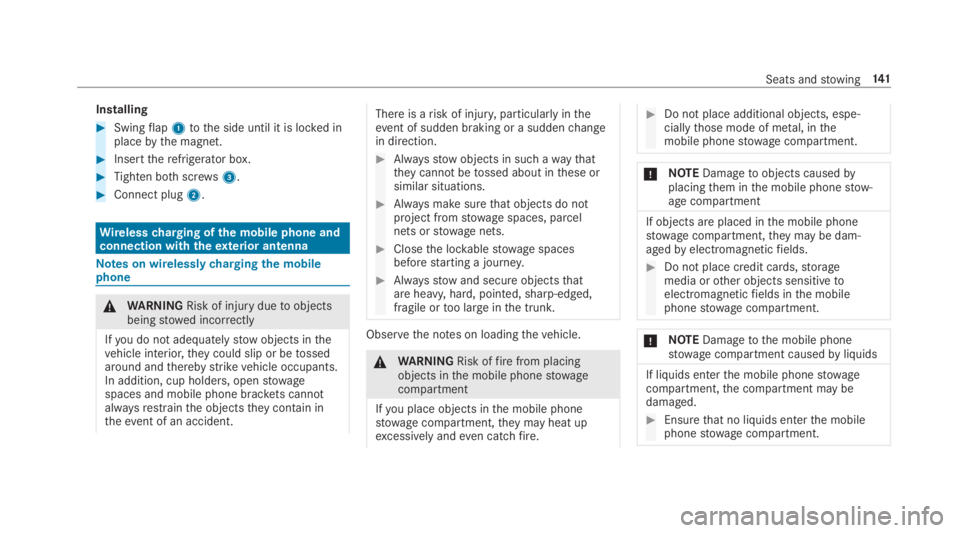
Installing
#Swingflap1tothe side until it is locked inplacebythe magnet.
#Inserttherefrigerator box.
#Tighten bothscrews3.
#Connect plug2.
Wirelesscharging ofthe mobile phone andconnection withtheexterior antenna
Notes on wirelesslychargingthe mobilephone
&WARNINGRisk of injuryduetoobjectsbeingstowed incorrectly
Ifyou do not adequatelystowobjects inthevehicle interior,theycould slip or betossedaround andtherebystrikevehicle occupants.In addition, cup holders, openstowagespaces and mobile phone brackets cannotalwaysrestrainthe objectstheycontain intheevent of an accident.
There is arisk of injury,particularly intheevent of sudden braking or a suddenchangein direction.
#Alwaysstowobjects in such awaythattheycannot betossed about inthese orsimilar situations.
#Always make surethat objects do notproject fromstowage spaces, parcelnets orstowage nets.
#Closethe lockablestowage spacesbeforestarting a journey.
#Alwaysstowand secure objectsthatare heavy, hard, pointed, sharp-edged,fragile ortoo large inthe trunk.
Observethe notes on loadingthevehicle.
&WARNINGRisk offirefrom placingobjects inthe mobile phonestowagecompartment
Ifyou place objects inthe mobile phonestowage compartment,theymay heat upexcessively andeven catchfire.
#Do not place additional objects, espe‐ciallythose mode of metal, inthemobile phonestowage compartment.
*NOTEDamagetoobjects causedbyplacingthem inthe mobile phonestow‐age compartment
If objects are placed inthe mobile phonestowage compartment,theymay be dam‐agedbyelectromagneticfields.
#Do not place credit cards,storagemedia orother objects sensitivetoelectromagneticfields inthe mobilephonestowage compartment.
*NOTEDamagetothe mobile phonestowage compartment causedbyliquids
If liquids enterthe mobile phonestowagecompartment,the compartment may bedamaged.
#Ensurethat no liquids enterthe mobilephonestowage compartment.
Seats andstowing141
Page 144 of 578
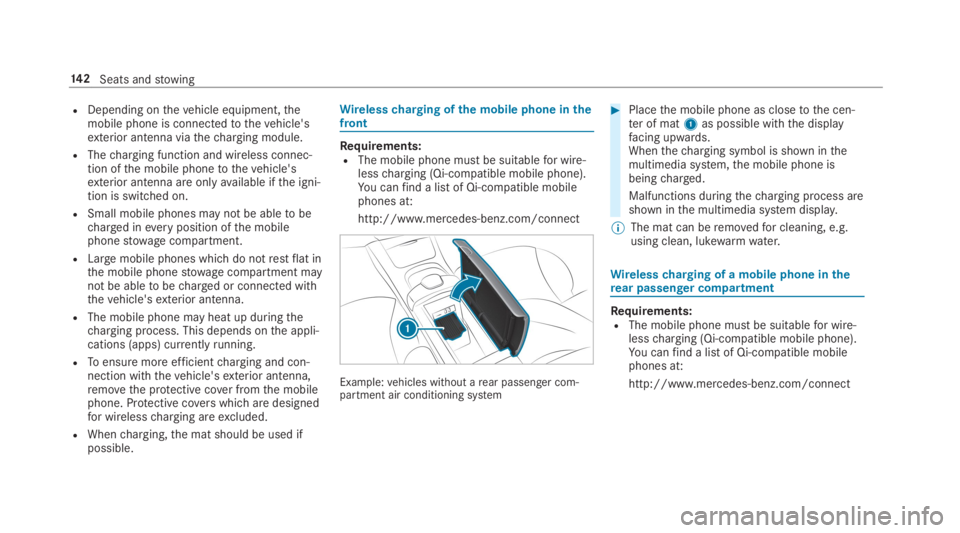
RDepending onthevehicle equipment,themobile phone is connectedtothevehicle'sexterior antenna viathecharging module.
RThecharging function and wireless connec‐tion ofthe mobile phonetothevehicle'sexterior antenna are onlyavailable ifthe igni‐tion is switched on.
RSmall mobile phones may not be abletobecharged inevery position ofthe mobilephonestowage compartment.
RLargemobile phones which do notrestflat inthe mobile phonestowage compartment maynot be abletobecharged or connected withthevehicle'sexterior antenna.
RThe mobile phone may heat up duringthecharging process. This depends onthe appli‐cations (apps) currentlyrunning.
RToensure more efficientcharging and con‐nection withthevehicle'sexterior antenna,removethe protective cover fromthe mobilephone. Protective coverswhich are designedfor wirelesscharging areexcluded.
RWhencharging,the mat should be used ifpossible.
Wirelesscharging ofthe mobile phone inthefront
Requirements:RThe mobile phone must be suitablefor wire‐lesscharging (Qi-compatible mobile phone).You canfind a listof Qi-compatible mobilephones at:
http://www.mercedes-benz.com/connect
Example:vehicles without arear passenger com‐partment air conditioning system
#Placethe mobile phone as closetothe cen‐ter of mat1as possible withthe displayfacing upwards.Whenthecharging symbol is shown inthemultimedia system,the mobile phone isbeingcharged.
Malfunctions duringthecharging process areshown inthe multimedia system display.
%The mat can beremovedfor cleaning, e.g.using clean, lukewarmwater.
Wirelesscharging of a mobile phone intherear passenger compartment
Requirements:RThe mobile phone must be suitablefor wire‐lesscharging (Qi-compatible mobile phone).You canfind a listof Qi-compatible mobilephones at:
http://www.mercedes-benz.com/connect
14 2Seats andstowing
Page 147 of 578
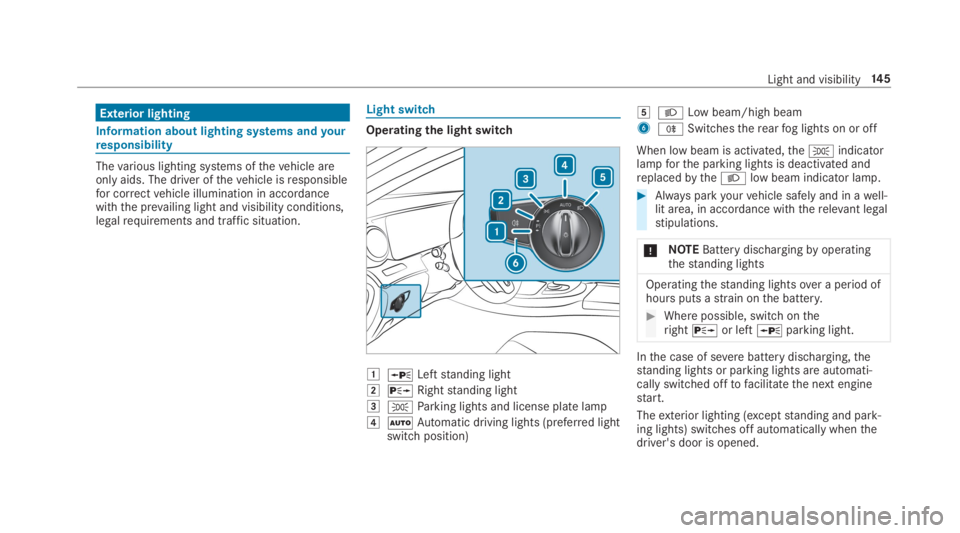
Exterior lighting
Information about lighting systems andyourresponsibility
Thevarious lighting systems ofthevehicle areonly aids. The driver ofthevehicle isresponsiblefor correctvehicle illumination in accordancewiththe prevailing light and visibility conditions,legalrequirements and traffic situation.
Light switch
Operating the light switch
�G�cLeftstanding light
�H�dRightstanding light
�I�`Parking lights and license plate lamp
�J�XAutomatic driving lights (preferred lightswitch position)
�K�XLow beam/high beam
6�^Switchestherearfog lights on or off
When low beam is activated,the�`indicatorlampforthe parking lights is deactivated andreplacedbythe�Xlow beam indicator lamp.
#Always parkyourvehicle safely and in awell-lit area, in accordance withtherelevant legalstipulations.
*NOTEBattery dischargingbyoperatingthestanding lights
Operatingthestanding lightsover a period ofhours puts astrain onthe battery.
#Where possible, switch ontheright�dor left�cparking light.
Inthe case of severebattery discharging,thestanding lights or parking lights are automati‐cally switched offtofacilitatethe next enginestart.
Theexterior lighting (exceptstanding and park‐ing lights) switches off automatically whenthedriver's door is opened.
Light and visibility14 5
Page 172 of 578
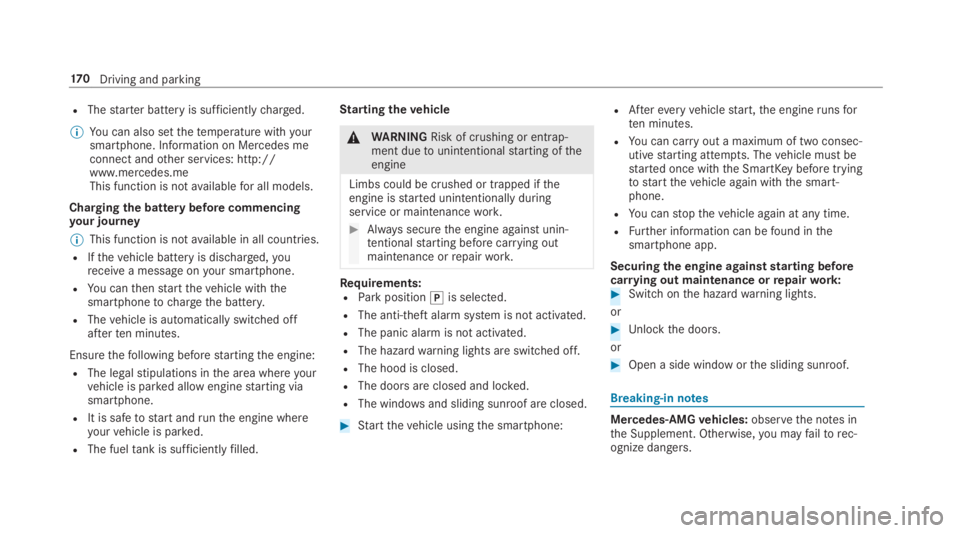
RThestarter battery is sufficientlycharged.
%You can also setthetemperature withyoursmartphone. Information on Mercedes meconnect andother services: http://www.mercedes.meThis function is notavailablefor all models.
Chargingthe batterybefore commencingyour journey
%This function is notavailable in all countries.
RIfthevehicle battery is discharged,youreceivea message onyour smartphone.
RYou canthenstartthevehicle withthesmartphonetochargethe battery.
RThevehicle is automatically switched offafterten minutes.
Ensurethefollowing beforestartingthe engine:
RThe legalstipulations inthe area whereyourvehicle is parked allow enginestarting viasmartphone.
RIt is safetostart andrunthe engine whereyourvehicle is parked.
RThe fueltank is sufficientlyfilled.
Startingthevehicle
&WARNINGRisk of crushing or entrap‐ment duetounintentionalstarting oftheengine
Limbs could be crushed or trapped iftheengine isstarted unintentionally duringservice or maintenancework.
#Always securethe engine against unin‐tentionalstarting before carrying outmaintenance orrepairwork.
Requirements:RParkposition�]is selected.
RThe anti-theft alarm system is not activated.
RThe panic alarm is not activated.
RThe hazardwarning lights are switched off.
RThe hood is closed.
RThe doors are closed and locked.
RThe windowsand sliding sunroof are closed.
#Startthevehicle usingthe smartphone:
RAftereveryvehiclestart,the enginerunsforten minutes.
RYou can carryout a maximum of two consec‐utivestarting attempts. Thevehicle must bestarted once withthe SmartKeybefore tryingtostartthevehicle again withthe smart‐phone.
RYou canstopthevehicle again at any time.
RFurther information can befound inthesmartphone app.
Securingthe engine againststarting beforecarrying out maintenance orrepairwork:#Switch onthe hazardwarning lights.
or
#Unlockthe doors.
or
#Open a side window orthe sliding sunroof.
Breaking-in notes
Mercedes-AMGvehicles:observethe notes inthe Supplement. Otherwise,you mayfailtorec‐ognize dangers.
17 0Driving and parking
Page 422 of 578
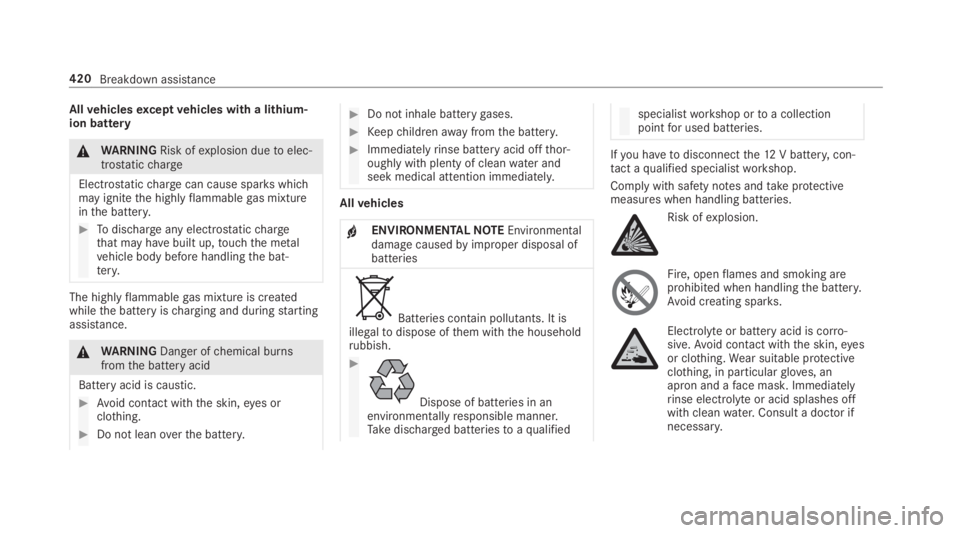
Allvehiclesexceptvehicles with a lithium-ion battery
&WARNINGRisk ofexplosion duetoelec‐trostaticcharge
Electrostaticchargecan cause sparks whichmay ignitethe highlyflammablegas mixtureinthe battery.
#Todischargeany electrostaticchargethat may havebuilt up,touchthe metalvehicle body before handlingthe bat‐tery.
The highlyflammablegas mixture is createdwhilethe battery ischarging and duringstartingassistance.
&WARNINGDanger ofchemical burnsfromthe battery acid
Battery acid is caustic.
#Avoid contact withthe skin,eyes orclothing.
#Do not leanoverthe battery.
#Do not inhale batterygases.
#Keepchildrenawayfromthe battery.
#Immediatelyrinse battery acid offthor‐oughly with plenty of cleanwater andseek medical attention immediately.
Allvehicles
+ENVIRONMENTALNOTEEnvironmentaldamagecausedbyimproper disposal ofbatteries
Batteries contain pollutants. It isillegaltodispose ofthem withthe householdrubbish.
#
Dispose of batteries in anenvironmentallyresponsible manner.Takedischarged batteriestoaqualified
specialistworkshop ortoa collectionpointfor used batteries.
Ifyou havetodisconnectthe12V battery,con‐tact aqualified specialistworkshop.
Comply with safety notes andtakeprotectivemeasures when handling batteries.
Risk ofexplosion.
Fire, openflames and smoking areprohibited when handlingthe battery.Avoid creating sparks.
Electrolyteor battery acid is corro‐sive.Avoid contact withthe skin,eyesor clothing.Wear suitable protectiveclothing, in particulargloves, anapron and aface mask.Immediatelyrinse electrolyteor acid splashes offwith cleanwater.Consult a doctor ifnecessary.
420Breakdown assistance
Page 423 of 578
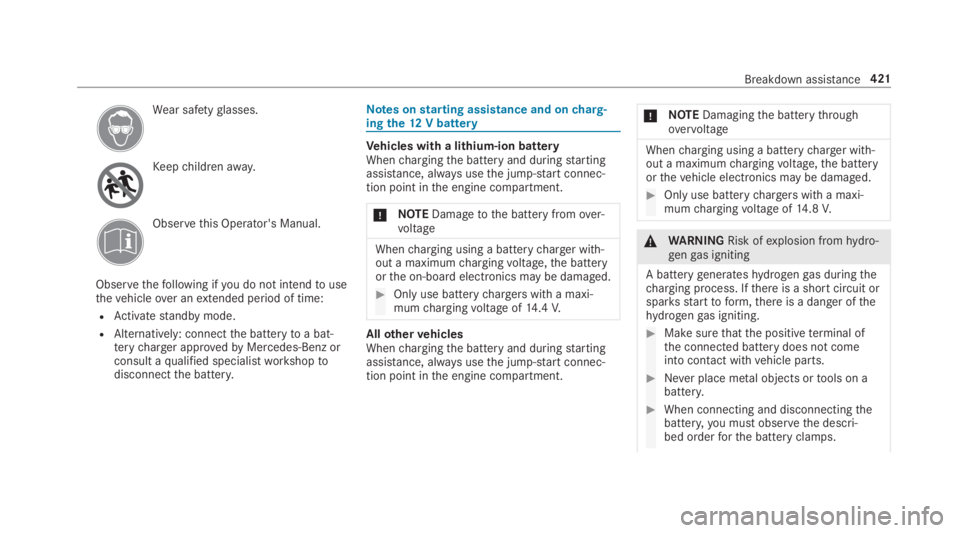
Wear safetyglasses.
Keepchildrenaway.
Observethis Operator's Manual.
Observethefollowing ifyou do not intendtousethevehicleover anextended period of time:
RActivatestandby mode.
RAlternatively: connectthe batterytoa bat‐terycharger approvedbyMercedes-Benz orconsult aqualified specialistworkshoptodisconnectthe battery.
Notes onstarting assistance and oncharg‐ingthe12V battery
Vehicles with a lithium-ion batteryWhenchargingthe battery and duringstartingassistance, alwaysusethe jump-startconnec‐tion point inthe engine compartment.
*NOTEDamagetothe battery fromover‐voltage
Whencharging using a batterycharger with‐out a maximumchargingvoltage,the batteryorthe on-board electronics may be damaged.
#Only use batterychargerswith a maxi‐mumchargingvoltage of14.4V.
AllothervehiclesWhenchargingthe battery and duringstartingassistance, alwaysusethe jump-startconnec‐tion point inthe engine compartment.
*NOTEDamagingthe batterythroughovervoltage
Whencharging using a batterycharger with‐out a maximumchargingvoltage,the batteryorthevehicle electronics may be damaged.
#Only use batterychargerswith a maxi‐mumchargingvoltage of14.8V.
&WARNINGRisk ofexplosion fromhydro‐gengas igniting
A batterygenerateshydrogengas duringthecharging process. Ifthere is a short circuit orsparksstarttoform,there is a danger ofthehydrogengas igniting.
#Make surethatthe positiveterminal ofthe connected battery does not comeinto contact withvehicle parts.
#Never place metal objects ortools on abattery.
#When connecting and disconnectingthebattery,you must observethe descri‐bed orderforthe battery clamps.
Breakdown assistance421